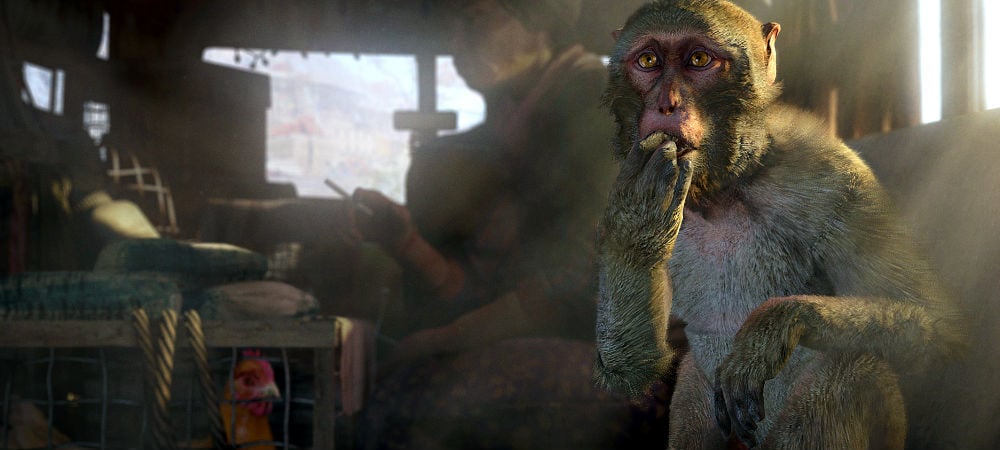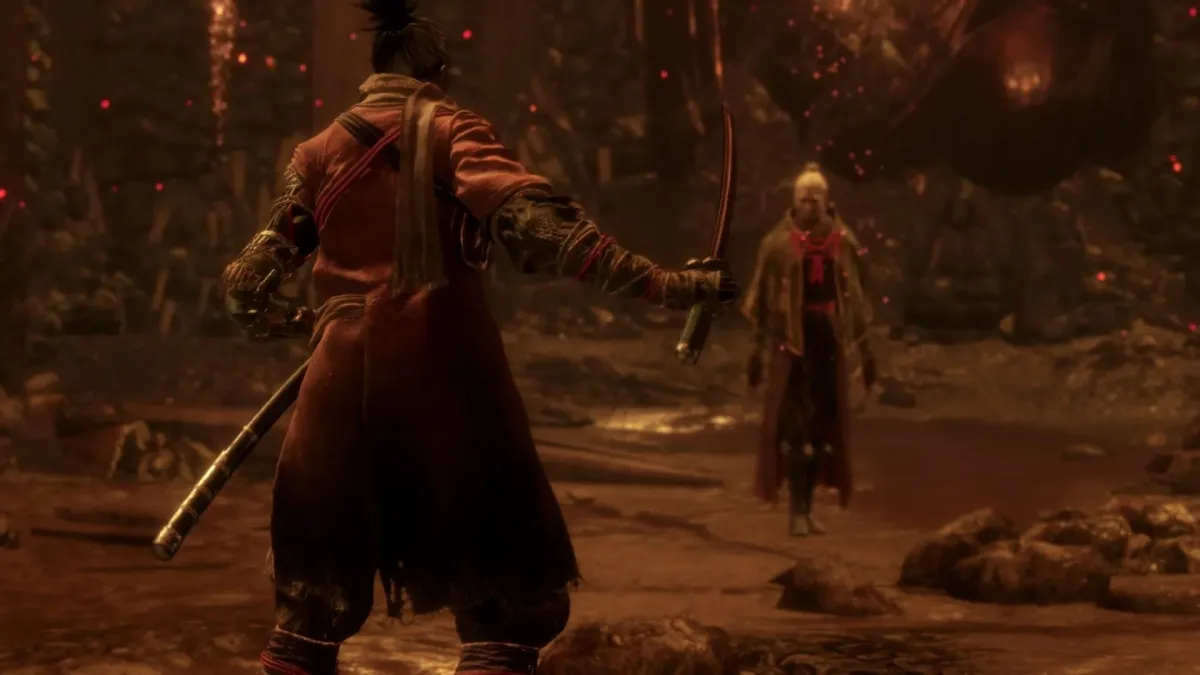Far Cry 3 was one of my favorite games of 2012. It didn’t stray too far from the normal sandbox conventions set before it, but gallivanting around beautiful island vistas and flying about with wingsuits was sweet.
For some that wasn’t enough, though, and for those folks, Far Cry 4 won’t be enough either. But for me, it’s still pretty damn fun.

Far Cry 4 (PC, PS3, PS4 [reviewed], Xbox 360, Xbox One)
Developer: Ubisoft Montreal
Publisher: Ubisoft
Release: November 18, 2014
MSRP: $59.99
Away from the archipelago of the Rook Islands, we now find ourselves in the vast expanse of the Himalayas in a land called Kyrat. The new protagonist, Ajay Ghale, has returned to his homeland to spread his mother’s ashes in Kyrat at her request. The only problem is Pagan Min, the ruling warlord. Min has history with Ajay’s family, and knows he’s coming. Ajay is thrown in the middle of an all-out war between Min and the Golden Path, a resistance movement led by Ajay’s father, thus sparking the narrative and giving you reasons to shoot things.
This time around Ajay is a bit less in-your-face than Jason was in Far Cry 3, and the game is more enjoyable for it. Ubisoft deliberately downplays most of the main character’s dialog, and while Ajay isn’t quite a silent protagonist, he doesn’t say a whole lot. While I’d definitely prefer a well-written, vocal lead character, Far Cry 4 puts the spotlight on the supporting cast, allowing players to focus on the action at hand from Ajay’s position as someone simultaneously new to Kyrat, but not quite an “outsider”.
The real star of the main event is easily Pagan Min himself, played to perfection by Troy Baker in one of his best turns yet. His outfit, mannerisms, and actions all make him a villain worth pursuing, and he steals the show every time he’s on-screen . Even the in-game guide is written by Min, offering up some humorous takes on the lore. His army has some more flavor than your typical mercenary crew found in most sandbox games as well, with proper in-world context to justify their outfits and abilities.
The story itself takes place over the course of 32 campaign missions, which will no doubt take ages to complete as you get distracted by pretty much everything else. There’s 24 outposts to take, over 200 collectibles to find, radio towers to scale, and 100 extra quests to complete. There’s also two major characters in the campaign to side with, and choosing one over the other will change the course of the story slightly and give you access to different missions. Of course, I spent the first 20 hours hunting and completely ignored the story. Just like Far Cry 3, it’s very easy to get distracted here.
There are also a small number of “Fortresses” to take, which are basically bigger and tougher outposts with individual alarm systems. The developers even hint in-game that you should complete story missions to weaken them first or take them by way of co-op (which I’ll get to later), but it’s an awesome feeling to carry on as a one-man army. Even if you haven’t earned enough skills to say, take down the Heavy units with a stealth kill, you can still work around it by systematically going around them to take everyone else out, then cut the alarms and improvise. They’re like miniature puzzles to solve, and are easily one of the stronger points in the game.
Taking them also affects the meta-story in Far Cry 4, as it stops the ongoing attacks to the outposts you’ve already claimed in that particular region. At first I was kind of annoyed that outposts could be reclaimed by the enemy, especially since losing one takes away a hard-earned fast-travel point. But after two of my posts were stolen I was emboldened to take the fort at any cost, which was a pretty awesome feeling and led to a real sense of accomplishment.
It’s this mechanic and the increased count of dynamic events that attempt to make the conflict in Kyrat seem more authentic. While in the end it’s still all very “gamey” and not truly organic, the experience never really feels dull. At nearly every turn some random event could happen, drawing you into an exciting car chase, or a rescue op to save a comrade from a army of honey badgers, when what you originally planned to do was hunt some docile little animal.
By the end of the story you may not care so much about the Golden Path, but you’ll remember all of your personal stories and interactions with the characters.

Once again the developers have nailed the actual shooting mechanics, and driving is improved this time around with the “auto-drive” button that lets you hand over the steering to the AI — allowing you to take in the sights, make a sandwich, or focus on shooting your sidearm while riding. Movement is still very open, as a heap of different travel options are out there including various cars, hang gliders, rudimentary flying machines, and even a grappling hook that has the power to scale mountains and swing from specific catch points. Elephants are fun to ride and stomp around with, but they’re even more fun if you’re watching them from a distance as they make ragdolls out of the enemy.
Due to the mountainous layout of the region, everything in Far Cry 4 is more vertical. For the most part getting around isn’t inherently difficult, but the mountains themselves can often obscure parts of the map, which makes them feel like gates to prevent you from getting to a location faster. It all opens up more as you explore and unlock more fast-travel locations, but there was something special about the vast seas of Far Cry 3 that really resonated with me.
While I personally prefer the less hilly setting of Far Cry 3, the exotic locale of Kyrat does have its perks. Not only is the wildlife more interesting, but the lore actually feeds more into the region in general, giving it more of a purpose than most sandboxes. It’s also beautiful on a current-gen system (especially during the Shangri-La dream sections), with long draw distances and incredibly impressive setpieces. The map most certainty does not have a cheap feel to it — you can see for what feels like miles, and it’s almost all accessible.

Don’t expect a whole lot from the Elephant (defense) and Tiger (offensive) split skill system though, as it unfortunately feels like a copy and paste from Far Cry 3‘s tree. While the rest of the game makes an effort to forge its own identity, the actual skills are still uninspired, to the point where some of them weren’t even worth picking up in the first place (not once have I found shimmying stealth kills or a faster repair ability essential). Karma on the other hand is actually a nice addition, offering a more traditional way to “level-up” with the locals by going out of your way to help. In return, you’ll get better deals on items and weapons as well as better assistance from the AI out in the wild.
All in all, the campaign is fantastic and completely worth buying Far Cry 4 for alone. But wait? Isn’t there multiplayer in there somewhere? Why yes!
Multiplayer comes in two flavors in Far Cry 4 — a competitive five-on-five mode called Battles of Kyrat, and co-op. The former is a basically by-the-books asymmetrical versus mode, with soldiers (Golden Path) going up against a more technical mystical group (Rakshasa) gameplay that leaves both sides with different powers. One side has more raw strength, the other is more tactical and can teleport, basically.

There are three modes — Outpost (base capture), Propaganda (bomb offense), and Demon Mask (capture the flag). You’ve seen this all before, and you’ve seen it done better. Though it is a serviceable addition, I feel the same way about Battles of Kyrat as I did with Tomb Raider‘s multiplayer — a zero sum gain that doesn’t help or hurt the campaign. Most players will just outright skip it.
Co-op on the other hand is a bit more enticing. In essence, you can flag your campaign session and play online (or completely avoid co-op altogether by starting your playthrough with the offline option), which lets random players or friends join your session for a bit of help or general tomfoolery. You can’t play story missions together but you can enlist them to take down just about everything else in your game world, including fortresses.
The limitations of co-op are probably the worst thing about it (it’s a pain to have to stop your crucial story progress and start up again), because it works as advertised and it’s actually quite fun. It would have been great if the other multiplayer bits were scrapped entirely in favor of creating a fully featured co-op mechanic that allowed for zero discrepancies though, because the feature feels less like a groundbreaking addition and more like a diversion. As a side note, the PS3 and PS4 platforms allow you to send out 10 two-hour trials to your friends, even if they don’t own Far Cry 4.

The last online component is probably the most interesting — the map creation and selection system. Here you can craft unique maps that have a variety of objectives like horde style gameplay or base defense, and unleash your creations to an online database. It’s very rudimentary and only supports one player (plus you have to log into uPlay to create), but it reminds me of the old PC mod days in many ways, especially with a few of the wacky maps that are out there right now with low-grav modifications and floating islands. I ended up playing it far longer than Battles of Kyrat, but the main event is decidedly the gigantic sandbox.
Far Cry 4 could have all of the multiplayer elements stripped away and it would still be a very strong game. If you enjoyed its predecessor and didn’t grow tired of Ubisoft Montreal’s open world formula, you’ll have a blast living the experience again.
[This review is based on a retail build of the game provided by the publisher.]










Published: Nov 14, 2014 08:00 am